| « Palace of the Occult Dramatizes a Little-Known Story About Hitler Adviser | In the Heart of the Sea, The Big Short, Macbeth, The Danish Girl, Theeb & Paradise Is There: A Memoir by Natalie Merchant » |
Art Fri Dec 11 2015
An Interview with Corinne Peterson: Healing the Split
"There is no greater agony than bearing an untold story inside you" -- Maya Angelou
Exposing truth, sharing untold stories, and releasing traumatic adversity can serve as a mental and emotional cleansing. In The Cairn Project, by Corinne Peterson, participants from the Chicago area are invited to join in workshops where they handle clay and porcelain, and share their trauma in order to see their light. Individuals are instructed to create a "rock" from clay to represent their inner darkness or trauma, and then create a small token of light, which is made from porcelain. Once the workshop is finished, Peterson displays a mound from the clay "rocks" and installs the porcelain tokens as a cloud of hope above the cairn.
Currently at the Lillstreet Art Center, Peterson's exhibition, "Cairn & Cloud: A Collective Expression of Trauma and Hope", was created with participants from 60+ workshops and includes various clay sculptures which entice meditation and reflection.
I sat down with the artist on two of her meditation seats in the exhibition space and discussed the ideas behind The Cairn Project and the universality of trauma and hope.
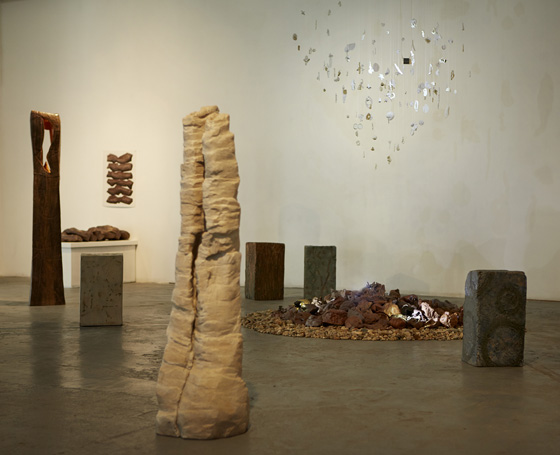
Installation View, Zhou B Art Center, courtesy of the artist
Can you talk to me a little bit about the Cairn Project?
It's an installation of work done by people taking workshops. In the "making" and in the "exhibiting," it's meant to help people relate to their compassion and their suffering. We all suffer, we all hope, we all have had some type of trauma in our experiences. We all have that indestructible core and the light within us.
Are the same clay pieces included in every exhibition?
Each exhibition has everything that was in the previous one plus whatever has been made in a workshop since then. This has at least 100 more rocks than the previous exhibition did. It's about 300 people that I've had workshops with at this point.
Can you talk about the particular groups that you work with in the workshops?
It's lots of different groups. The very first one was with a group of friends. It was a pilot workshop to see whether what I had put together was something that people would want to do. I had the idea of doing the cairn where people would be making a rock form that expressed their suffering. I thought to myself, "Who's going to want to take a workshop like that?" I didn't know if people wanted to do that.
I thought about the cloud part, the tokens of light, as showing why this could be a good experience because people are bringing their light and their compassion to it. The workshop with my friends was a profound experience. All of us have had some kind of trauma. I think a kid doesn't grow up in the culture to be taught to not feel what they feel, or express what they really feel. Since then I've done the workshops with blind and visually impaired, a group called NAMI, which is composed and run by people who have mental illness, Mexican immigrants, Iraq refugees, Burmese refugees, Burundi refugees, nurses, two sibling support groups for kids whose sibling was sick with cancer, and another for kids who had actually lost a sibling.
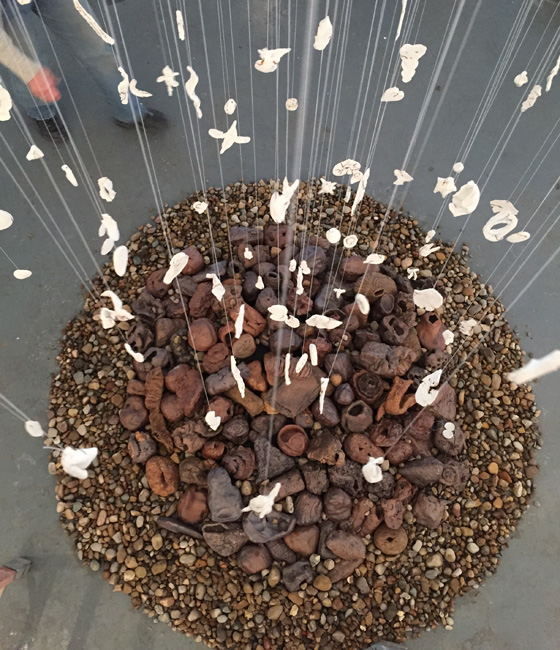
"The Cairn and the Cloud", courtesy of the artist
What is the feedback like for the workshops?
Thankfully I get a lot of feedback because I have a response form so I have a long list of their comments. The bereavement group had a lot of positive feedback. They commented on the safe place, the quiet, the calm, the sensitivity of the workshop. I did one workshop with 27 transgendered youth. We divided into three groups. Many of them commented on how great it was to not have to talk and to be quiet. In each workshop, when they are making the rock form about their trauma, or making the porcelain token of hope, we introduce it with a guided meditation and ask them to not talk with each other. I'm encouraging them to have an inner conversation. For the transgendered group, it was a relief for them. They were ages 12-20. This was a good thing for them.
Where did the original idea for this project come from?
Several different things came together to give me this idea. I was a psychotherapist and a social worker before I began creating art. I had dreams about clay and I was in the midst of my own Jungian analysis. It was a way for me to heal some of my trauma and discover what it was. It was an extremely informative and healing experience for me. In the last 2-3 years, I've been especially interested in reading about how trauma affects the brain and causes it to split and also how meditation is a means of healing. There is so much research now about how the brain can change and what you can do to it to change it, for the better. I had been actively meditating and reading about all of this.
Then I went on a trip to Sweden and Norway where I was going to visit different places that had ancient standing stones because they were an influence on my making sculpture. When I was there I saw a lot of different kinds of tombs and among them was this huge cairn, 5,000 years old, that for centuries had been used as a burial cairn. That was pretty impressive. After I came back to the US, I realized that I didn't want to make any artwork that wasn't fueled by my authentic self. I didn't want to thoughtlessly continue with what I had been doing. I had an exhibition between me and my kids and I thought, "Now what?"
I started to make small stones. I made 36 stones and I made them because I had a dream that I was putting them up on a wall, arranging them in a grid. I thought, "I don't know what this dream is about, but I should make them." As I worked on them it seemed like alchemy, like they were the nigredo, the dark matter. Each one represented some experience of suffering. I had a realization that to work authentically was to look honestly at your experience in a deep way. Then, I was in the Accelerator ArtSpace at the Elmhurst Art Museum and they have a real accelerator from the atom-splitting days at the University of Chicago and I thought, "I should have a show here because all of my work is about splitting and healing." I thought of the cairn I saw in Sweden and the pieces that I had made. So I thought, "I could make a cairn." I almost immediately thought about how I could incorporate my own social work self together with my art self and hold workshops and invite people to make pieces for this. I thought, "I have to do this." And I did. That was in February and my mind was on steroids all spring. In June, I had the first workshop.
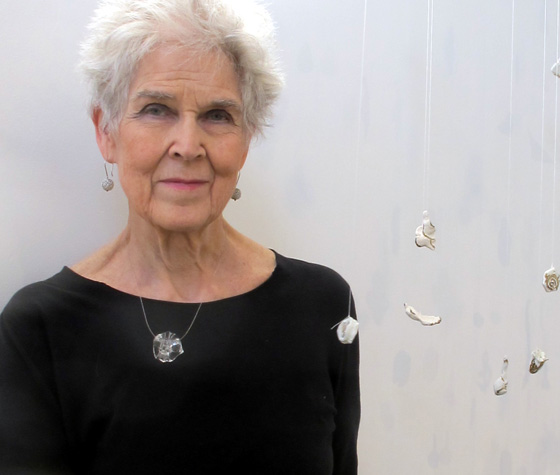
Corinne Peterson
When did you decide you wanted an aspect of hope with the cairn?
Almost immediately. Definitely in meditation which I was involved in, there is the idea of equanimity where you're aware of all of the raw things in life.
Hope and trauma are both always together and present.
Exactly. This was bringing compassion and light to the trauma experience. We have within us the ability to bring comfort to ourselves. In the workshops, the other people in the group don't necessarily know anything about what your story is. Everyone is invited to share their story but nobody has to say anything if they don't want to. The group where people shared the most deeply and most freely was with the Iraqi refugees. The pieces that they were making were very much about their deepest traumas. They started talking to each other about what they were making, like the cave they had hid in, or being at the top of the mountain and leaving behind their home. They all talked and it became a really free conversation.
What have you gotten out of the entire project? Hearing all of these people's stories and talking to all kinds of groups that you might not normally be around must really have an impact on you. How has it affected your practice?
Right, right. First of all, I would say that my default way of being, the way I grew up, was to dissociate away from my feelings. This project is a big opportunity to not do that. Every time I get ready for a group, or I'm meeting with a group, it's pointless if I'm dissociated from myself. I have to call myself back and be present. It's been a stretching process for me. Whenever you think about a group, you think about a particular kind of experience they have had. It makes me think more deeply about experiences.
When I did the workshop for the blind, I had to think about how we would adjust the workshop. At first, I could only think about the limitation of not being able to show them things. Then I thought, their hearing and their tactile sense is stronger than mine. It was terrific. I want to help people recognize that stones are like a metaphor for life, there is no such thing as a stone that isn't formed or changed apart from trauma. At the beginning of the workshop, people choose a stone and they use it to introduce themselves. For the blind group, that was a very tactile connection with the project from the start. The other overwhelming thing is that I have an expanded sense of human suffering and of hope.
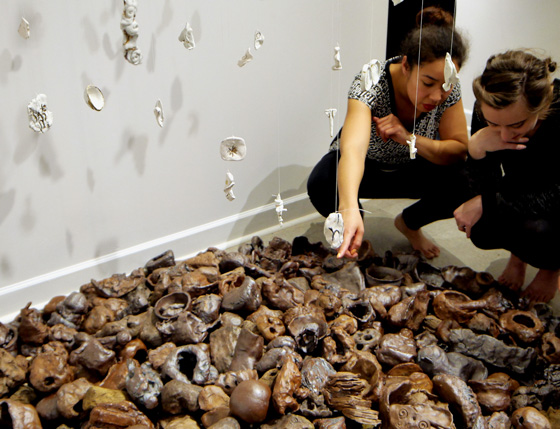
Detail of The Cairn Project, courtesy of the artist
Could you talk a little bit about your idea of "splitting." You briefly mentioned it before but I would like to hear the background a little more in depth.
It's very much about the kind of amazing experience of not having any feeling and knowing that you have a feeling about it. For me, sometimes it's like being on the outside of myself and looking in on myself where the real life is -- I'm kind of separated. I first became aware of this years and years ago when it was Christmas. I had three wonderful kids and I realized I felt no excitement about anything. It's like a depression.
...like a numbness.
Yeah, yeah. I think it's pretty common in one way or another for people. It's become more and more of a mission for myself to be fully connected. I'm always afraid to be open. When I first started doing art I became connected to the part of me that I was in therapy about. I was able to put what I feel inside into a concrete form. I realized that even though I was experiencing the split, there was a united base.
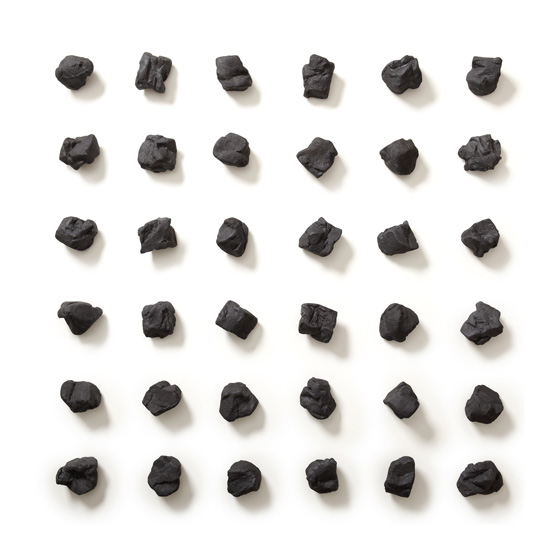
"Nigredo Grid", courtesy of the artist
What is the future of this project?
In reality, it's open ended right now. The plan is that I'm carrying this though 2016 and the plan is to end with a two-month exhibition at Citlalin Gallery. It's a large space and I like the feel of it. They have a whole extra room so the thought is to accompany it with other events -- dance, poetry readings, some people's responses to the work. I want to find a permanent place for the cairn to be exhibited. Some place that is related to trauma, whether it's a hospital, or a school of some sort. I may have more exhibitions. Sarah Gottlieb has BodyCompass Dance Project, who specifically focus on the body, and the memory of trauma, and respond to that. They have accompanied the project at every exhibition. They would certainly accompany the final exhibition next year. My friend Ginny Sykes is probably going to join in with some of her work and she may develop a performance for it. We may have a call for dancers and try to get short pieces from a variety of different artists involved during the opening night.
"Cairn & Cloud: A Collective Expression of Trauma and Hope" will be at the Lillstreet Art Center until January 3. Lillstreet is located at 4401 N. Ravenswood.








